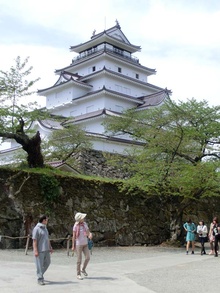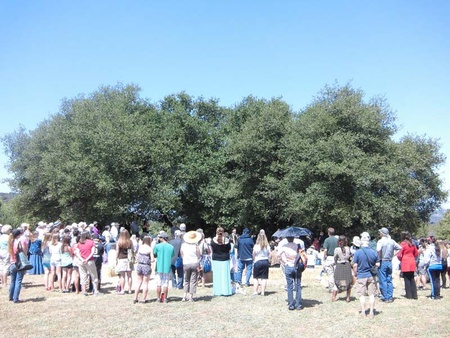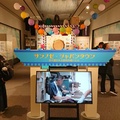There is something sympathetic about the stories surrounding the Aizu clan from the end of the Edo period to the Meiji period, and there are many history buffs who are fans of Aizu. Aizu was crushed by the government army (called the Western Army in Aizu) in the Boshin War, and was reduced to the Tonan Domain in the frigid Shimokita Peninsula, where it suffered hardships.
"Perhaps the people of Aizu still harbor resentment from those days, which is why the castle town exudes such a unique atmosphere."
I visited Aizuwakamatsu after the Golden Week holidays in May with these assumptions in mind, but I found that this was an overreaction on my part. The town was bustling with tourists from all over the country, thanks to the popularity of the NHK historical drama "Yae no Sakura."
Pale pink cherry blossoms still remained in the castle ruins park surrounding Tsuruga Castle, the symbol of Aizu.
There are many historical sites and tourist attractions in the area, including the Taiga Drama Museum, which shows behind-the-scenes information about the drama, the restored Aizu samurai residences, Imoriyama, where the Byakkotai soldiers rest, and Nisshinkan, where the samurai were educated.
A historical tale to be passed down
However, unlike these, there is a small historical monument in the city that rarely gets any attention. To the east of the Aizu Basin, which is surrounded by mountains, near the top of Mount Seaburi, an 870-meter-high mountain that separates it from Lake Inawashiro, there is a scenic spot called Kanpaku-daira, where Hideyoshi once rested, offering a panoramic view of the Aizu Basin.
In one area, there is a white stone monument. It is set on a large stone and has an arched top, giving it a shape that can be described as a mix of Japanese and Western styles. Just like its shape, the characters carved on the monument are also a mix of Japanese and Western styles. On the front of the slab-shaped monument, written horizontally in English,
"In Memory of OKEI Died 1871 Aged 19 Years"
And on the back, in the center, vertical writing:
"Okei's Grave"
On either side of it are the words "The sun set on the 1st day of the Meiji era of the Japanese Empire" on the right and "Age at death was 19 years old" on the left. This is literally the gravestone for "Okei's Grave."
A woman named "Okei" died at the age of 19 in 1871 (Meiji 4). This is a grave in memory of her. Why is there a grave of a woman named "Okei" here, all by herself? Who on earth was this "Okei"?
The year 1871 was just three years after the Aizu clan had been defeated in the Boshin War. The people had scattered and left the town, and the Aizu clan samurai had been transferred to Tonan. However, it was in this same year that the Tonan clan was abolished when the clans were abolished and prefectures were established.
Living in the same era as Yae
Okei was 19 years old that year, which makes her about seven years younger than the protagonist of the historical drama, Yae Yamamoto, who was born in 1845. In the context of Yae's life, in 1871, Yae headed to Kyoto relying on her brother Kakuma, who she found to be alive.
It can be said that the two women lived in the same era, but while Yae overcame hardships, carved out a new future with her talent and drive, and lived a long life, the nameless Okei, also from Aizu, passed away at the age of just 19, far away in California.
But Okei lived a very special life, and stories about her are still told in Aizu-Wakamatsu today. She is believed to have been one of the first recorded Japanese women to emigrate to the mainland United States.
On this clear May day, the tombstone was facing the town of Aizu, which spread out in the distance below. The people who made the tombstone did so so that Okei could at least look out at his hometown even after he had passed away. However, in reality, Okei never set foot on the soil of his hometown again.
She spent her final days in a foreign country, and her real grave stands on a hill in the countryside of California. The grave on Seaburiyama was later built by the people of Aizu so that she would not be forgotten in her hometown.
A quiet grave in Gold Hill
On May 18th, eight days after I visited Okei's grave in Aizu, under the clear sky of California, I was standing in front of the real "Okei's grave." The grave is located about 70 kilometers northeast of the state capital, Sacramento, in the mountains.
The area is called Gold Hill, which literally translates to "golden hill" in Japanese, evoking the image of a land that boomed during the gold rush.
The grave stood alone on a small hill amid the rolling hills, protected by a few trees. It was surrounded by an old iron fence, and the natural mass of rock or stone, together with the fence, formed a square cemetery.
On this day, people gathered in this area, which is usually unpopulated, from mid-morning as if they were having a picnic, and a crowd had formed in front of the grave. The Wakamatsu Farm Festival, now in its third year, was being held there.
Wakamatsu is the name of the young pine tree in Aizu-Wakamatsu. Just after the Meiji Restoration, there was a colony here established by Japanese people who had immigrated from Aizu-Wakamatsu, and Okei was among them.
Why and how did they leave Japan and come to this land? What was their fate? Why was Okei's grave built? This will take a little longer, but I would like to explain the circumstances.
*This article is reprinted from JBPress (Japan Business Press) (published on June 17, 2013).
© 2013 Ryusuke Kawai, JB Press













